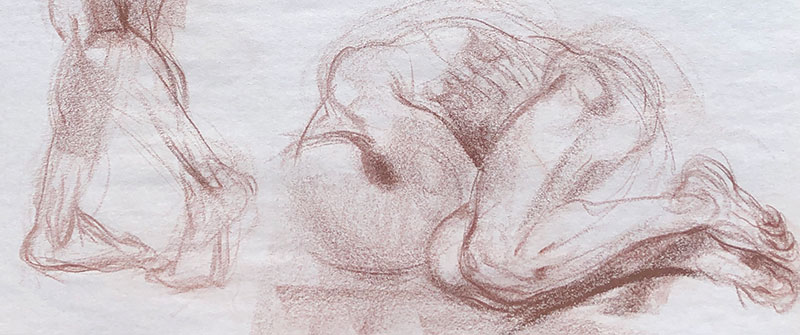Art Prof Clara Lieu explains the “major masses” of the human figure, the largest forms: the head, rib cage, pelvis, and thighs.
- Watch the 2 min. version
- Watch the 4 min. version
- Watch the 37 min. version
- Watch the Draw Along
Prof Lieu illustrates how the major masses are oriented on the figure and how this contributes towards understanding the gesture of the human figure more clearly.
The major masses are angled in relation to each other, it’s a fundamental part of the way the human figure is structured and an important premise to grasp before moving onto the smaller, more specific parts of the anatomy.

Video Walkthrough
- The major masses are the largest forms on the figure: the head, rib cage, pelvis, and thighs.
- If you establish the major masses well, it almost doesn’t matter what happens with the rest of the figure.
- Identify the big shapes first.
- You have to train your eye to see past the details and see the biggest shapes first.
- Prioritize the angles of the masses.
- What’s important is how the angle of each major mass relates to the other.
- For example, the rib cage tilts forward while the pelvis tilts back.
- There are tons of systems and measurement systems online for drawing anatomy that are inaccurate.
- Many of these measuring systems tell you to draw shapes into the human figure that don’t exist and have no grounding in the actual anatomical structure.
- The figure is not a stack of blocks.
- The common assumption is that in a standing figure, every part of the figure is standing up straight.
- Draw the angles of the major masses in relation to each other, look at one major mass as you’re drawing another.
- The angle of the neck can be tough to see, you have to be conscious of it and then really work to see it.
- Without pushing the angles of the major masses, you’ll end up with figure drawings that look very stiff.
- It’s the angles of the major masses that will make your figure drawings feel more natural and fluid.
- The necks tilt in relation to rib cage, which tilts forward.
- It makes sense that the thighs tilt back in relation to the forward tilt of the rib cage, as that tilt helps the figure balance the weight distribution of the masses.
- The thighs tilt back, and it’s not until the lower section of the leg that the limbs sit straight up.
- Get yourself into the pose of the figure you are drawing, where do you feel tension in the pose?
- You can follow the angle of the nose in order to figure out what the rest of the head is doing.
- Exaggerate the angles of the major masses, most of the time people don’t angle them enough and the figures feel very stiff.

Films mentioned
As a free educational source, Art Prof uses Amazon affiliate links (found in this page) to help pay the bills. This means, Art Prof earns from qualifying purchases.



